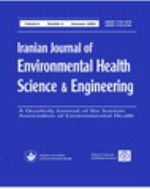
|
Iranian Journal of Environmental Health, Science and Engineering
Iranian Association of Environmental Health (IAEH)
ISSN: 1735-1979
Vol. 7, No. 3, 2010, pp. 273-278
|
 Bioline Code: se10031
Bioline Code: se10031
Full paper language: English
Document type: Research Article
Document available free of charge
|
|
|
Iranian Journal of Environmental Health, Science and Engineering, Vol. 7, No. 3, 2010, pp. 273-278
| en |
Determination Of Nanofiltration Efficency In Arsenic Removal From Drinking Water
Akbari, H. R.; Mehrabadi, A. Rashidi & Torabian, A.
Abstract
Nowadays nanofiltration has been considered for the treatment of organic and inorganic pollutants in surface and groundwater resources. In this study, rejection characteristics of arsenic compounds such as As(III) to form As2O3 and As(V) to form Na2HAsO4.7H2O by a commercial nanofilter NF90 (DOW-FilmTec) was investigated. Arsenic rejection experiments included variations of feed arsenic concentration, transmembrane pressure and pH. In these experiments, as increasing initial concentration As(V) from 120 μg/L to 1026 μg/L in feed water, the percentage of rejection of As(V) decreased from 98.35% to 96.59% (permeate water concentration was 2 μg/L to 35 μg/L) ,while as increasing initial concentration As(III) from 118 μg/L to 985 μg/L in feed water ,the percentage of rejection of As(III) decreased from 94.07% to 87.51% ( permeate water concentration was 7 μg/L to 123 μg/L). Due to increase of pressure from 4 bar to 7 bar, the percentage of rejection of As(V) in finished water increased from 95.68% to 99.02% (permeate water concentration decreased from 21 μg/L to 5 μg/L),while the percentage of rejection of As(III) decreased from 80.99% to 95.11% (permeate water concentration decreased from 96 μg/L to 25μg/L). Also due to increasing pH from 3 to 11, the percentage of rejection of As(V) in finished water increased from 95.45% to 99.00% (permeate water concentration decreased from 22 μg/L to 5 μg/L), while the percentage of rejection of As(III) decreased from 86.6% to 94.81% (permeate water concentration decreased from 65 μg/L to 25 μg/L). Finally, nanofiltration application for arsenic removal from drinking water was recognized suitable regarding its proper efficiency and convenience operation and was recommended for point-of-use applications.
Keywords
Nanofilteration; Arsenic; Nernst Planck equation; Donnan equilibrium; Drinking water
|
| |
© Copyright 2010 Iran Journal of EnvironHealth Sci Eng.
Alternative site location: http://diglib.tums.ac.ir/pub/
|
|
